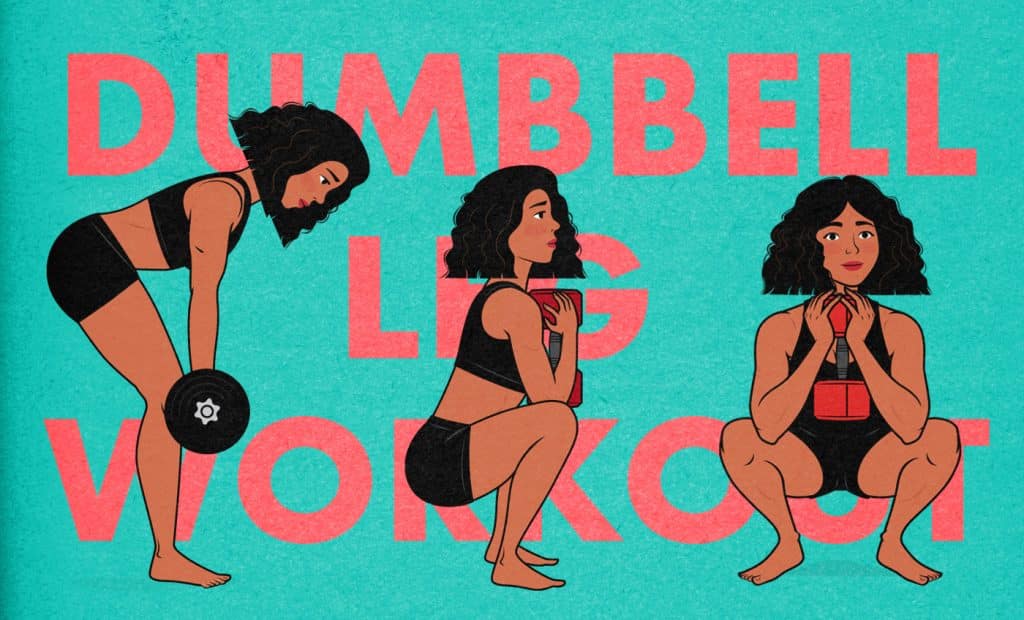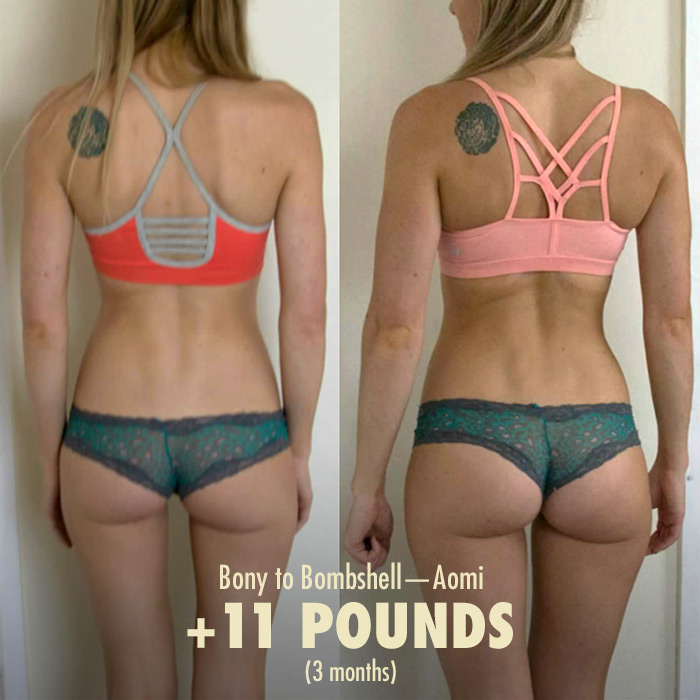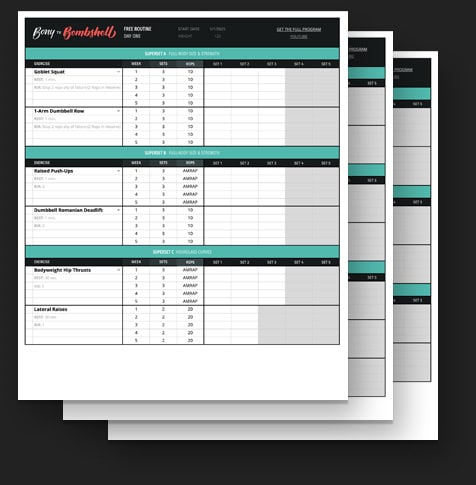
Dumbbell Leg Workouts For Women
Dumbbell exercises are just as good for building muscle as barbell, cable, and machine exercises. That means we can build a full dumbbell leg workout, and it will work just as well as if you were training in a full gym.
The trick is to use a combination of squats (like dumbbell goblet squats) and hip hinges (like dumbbell Romanian deadlifts) and to include a one-legged variation (like a dumbbell split squat, step-up, or lunge). After that, if you want bigger calves, you can add in some calf raises. Or, if you want especially fast glute growth, you could do some extra hip thrusts.
- Dumbbell Leg Training Overview
- Dumbbell Leg Workout Overview
- Leg Muscles We’ll Need To Work
- Squat Compound Movement—Dumbbell Goblet Squat
- Hip Hinge Compound Movement—Dumbbell Romanian Deadlift
- Glute Maximus Isolation—Dumbbell Glute Bridge
- Glute Medius/Minimus Isolation—Book Clamshells
- Calf Isolation—Dumbbell Calf Raises
- Use A Low To Moderate Rep Range
- Challenge Yourself But Stop Shy Of Failure
- Start With Two Sets, and Add More When Needed
- Rest 1-2 Minutes Between Sets
- Free Dumbbell Leg Workout For Female Beginners: Full Routine
- Q&A About DB Leg Workout
- What Next?
Dumbbell Leg Training Overview
Benefits Of Working Out Your Legs
- The biggest opportunity for new curves. Your legs are incredibly powerful because they are some of the biggest muscles in the body. That gives them a larger opportunity to grow big than other, smaller muscles.
- Curvy, toned legs can make you look more feminine. Sexual dimorphism means the differences between males and females. Men have an innate drive towards building upper body mass, like wider shoulders and a thicker neck (for protection and hunting). For women, it’s more about a thin waist and a curvier lower body with wider hips (signs of fertility.) Research shows that women store omega-3 fatty acids on the hips, and men instinctively know that curvy and strong hips can help to build a baby’s brain. Aside from improving your diet, doing more leg workouts can help to tone the leg, add curvy muscle mass, and bring general blood flow to the area, helping the legs look better and more feminine.
- It’s good for your posture. Your leg muscles include many stabilizer muscles around your pelvic and hip area, which are critical for good posture. Many of the best dumbbell leg exercises, like Goblet squats, are great for filling in weak postural muscles all around the hips, the inner thighs, and even the lower back.
- It’s good for your heart and general health. Your leg muscles are great for burning up high blood sugars without using insulin, just through muscular contractions. Your calf muscles have been called the “second heart” because their contractions can help to push blood around the body. Walking and doing squats are both great tools.

Pros Of Using Dumbbells For Leg Training
- You can train at home. If you get an adjustable dumbbell, you can even tuck away an entire gym into the hall closet in a small apartment. No gym membership is needed. Full privacy, it’s less gross, and it’s cheap.
- Small set-up time. With dumbbells, you just grab them and get to work. Even adjustable dumbbells while they take some time to switch weights, compared to loading up a barbell—it’s a cinch.
- Full range of motion. Many exercises have their range of motion cut because the barbell or the machine has a fixed path of motion it can travel. Dumbbells can twist, they can be held in different ways (like a goblet, for example), and so the range of motion of an exercise can increase. This can not only help limit injuries by having a more natural path that matches your body, but you can get curvier, rounder muscles by getting into a deeper muscular stretch.
Cons of Using Dumbbells For Leg Training
- They’re lighter compared to barbells or machines. Your legs are so strong that many people believe a light dumbbell can’t stimulate them enough compared to a stable and heavy barbell. But there’s a trick to this downside—you can do unilateral work to make the same weight heavier on one leg. What this means is you do one leg at a time. For example, you can do Bulgarian split squats, one-legged hip thrusts, etc. It takes a little longer since you have to do both sides, but you can still get a great workout in.
Dumbbell Leg Workout Overview
Leg Muscles We’ll Need To Work
To get the best possible leg workout, it helps to understand the different muscles. We’ll need to work the:
- Quads. These are the front of the thighs. They get worked best with a knee-dominant movement like the squat.
- Hamstrings. These are the back of the thighs. They get worked best with a hip-hinging movement as if someone is bending over to pick up something off the ground.
- Glutes. There is the gluteus maximus and the glute minimus and medius. If you want exceptional glutes, you’ll want a variety of exercises that hit them in all directions. They help move the hips forward, rotate the legs, etc.
- Calves. At the risk of obviousness, these muscles are on the lower leg, below your knee. You can work them by flexing the ankles. Calves will never be the limiting muscle in compound exercises, so if you want them to grow, they’ll need isolation work. (But not all women want their calves larger.)
Squat Compound Movement—Dumbbell Goblet Squat
The dumbbell Goblet Squat is one of the best exercises for your legs—bar none. With the weight in front of you, the dumbbell will act a bit like a counterbalance. This will allow you to sit back a bit more, allowing you to squat much more deeply without your hips jamming and your lower back rounding at the bottom of the movement and getting the dreaded “butt wink.”
When you can squat down deeper with better form, that will allow your muscles to engage properly through a deeper range of motion, getting a better loaded stretch. When that happens, muscle growth in your legs explodes, and your muscles get worked in a new way that’s unexpected.
- Stand with your feet apart in your strongest stance (as if you were going to jump or maybe a tiny bit wider)
- Hold the dumbbell up and cup your hands underneath, like you’re holding a giant goblet chalice.
- You can hold the dumbbell right next to your chest.
- Get as tall as you can, and take a deep breath in.
- Slowly lower yourself under control by sitting back and bending your knees at the same time.
- Keep your knees out over your feet/ankles, and don’t let them cave inwards.
- Squat down as low as you can comfortably. Do not force the movement lower than you can. (When you can’t go any further properly, your lower back will round downwards, which is called a butt wink.)
- Push through your whole foot as you exhale, and stand back up.
- That’s one rep.
Hip Hinge Compound Movement—Dumbbell Romanian Deadlift
The dumbbell Romanian deadlift (otherwise known as the DB RDL) is a compound lift that targets the following:
- entire posterior chain (the back side of your body)
- the hamstrings (back of thighs)
- the glutes
- postural muscles, such as the spinal erectors most easily seen on the lower back
To a lesser extent, the RDL will also train your forearms, upper back to stabilize the weight, etc. This is an incredible exercise for the entire back of the legs and helps with reversing slumpy posture.
- First, grab two dumbbells that you can handle properly.
- Walk away from the dumbbell rack and find a place you have enough space to do the exercise.
- Stand with your feet hip-width apart, in a power position, as if you were going to jump.
- Get as tall as you can, stretch out, and take a deep breath.
- Pretend there’s a rope tied around your waist, and it’s pulling you backwards.
- Push those hips back while keeping your head in line with your body, keeping a “neutral spine.”
- Keep going back until you feel the tension in your hamstrings.
- Once there is enough tension, use your hamstrings like an elastic band to snap back up.
- Thrust your hips forward, using your glutes to get back into the starting position as powerfully as possible.
- That’s one rep.
Glute Maximus Isolation—Dumbbell Glute Bridge
The glute bridge has a fairly small range of motion compared to the hip thrust, but it does isolate the glutes better. It can be a great exercise for building up a pump in the glutes. When done in combination with DB goblet squats and DB RDLs, they can do a great job of speeding up glute growth.
In the video below, Marco coaches Marielle to do a glute bridge, first with a dumbbell, then a weight plate, and then a full out barbell set-up.
- Grab a dumbbell you can handle well.
- Lay down, bring your feet up close to your bum, and shimmy the dumbbell on your lap.
- Push through your heels and drive the dumbbell up with your hips.
- Lower the weight slowly under control.
- That’s one rep, do all the reps you need to, and then shimmy the went off of you.
Glute Medius/Minimus Isolation—Book Clamshells
The glutes’ main job is helping the pelvis go forward. But if you want to round them out to make them curvier and fuller, make them work at rotating the legs. This will help hit the gluteus medius and minimus.
A dumbbell will likely be too heavy for this exercise (unless you have very light dumbbells), so you can use a heavy book to help load up the clamshell.
- Lay down on one side of your body, and bring your knees up a bit.
- Rotate your knee out while keeping your feet together.
- You should feel a burn on the outer side of your butt.
- If this is too easy, add resistance with a heavy book, a weight plate, or a very light dumbbell.
- Repeat on the other side.
Calf Isolation—Dumbbell Calf Raises
You can skip this one if you already have large calves (some women do). But if you’ve got stubborn calves, you’ll need to give them some work. These are pretty simple. All you need to do is find an edge, like a stair or a small, sturdy box, and start flexing those ankles.
- Find a ledge, sturdy block that can support you, or a calf raise machine.
- Place the front of your foot on the edge—the ball of your foot
- Press as you point your toes down
- Feel the burn in the calf muscles
- Lower the body until your toes are pointing up and there’s resistance
- Do the next rep
- If it’s too easy, do one footed calf raises or weight it by holding onto dumbbells.
Use A Low To Moderate Rep Range
In research, to optimize for muscle growth and muscle size, you want to choose a weight that you can do 4–40 repetitions with. The sweet spot in real life, though, for leg exercises is in the lower rep range of around 5-12 reps. The reason why is because the legs are such a big and powerful group of muscles and can be very fatiguing.
If you find yourself not able to do 5 reps, use a lighter dumbbell. If you can do more than 12 repetitions, use a heavier dumbbell. If you don’t have a heavier dumbbell, switch to harder leg exercises or start doing unilateral work (one leg at a time) to make it heavier on the legs.
That will guarantee that the workout is helping you gain both muscle size and muscle strength and not making endurance adaptations.
Challenge Yourself But Stop Shy Of Failure
Ideally, you’ll stop your set when you’re just about to fail and have a rep or two left in you. But if you’re a beginner, it’s hard to know exactly how hard you’re pushing yourself. If you aren’t sure if you’re taking your sets close to failure, try doing more reps. For example, try pushing yourself in one set all the way until you can no longer do any more goblet squats with perfect form. That way, you’ll know what it feels like. You might be surprised that you were a lot stronger than you thought. Next time, stop right before that point of failure.
Start With Two Sets, and Add More When Needed
Start with just a couple of sets, then over time, add more sets as you get stronger. We recommend doing two sets in the first week. Practice your form, find the right weights, and take your time learning the exercises.
Next week, if you aren’t too sore at the start of each workout, try adding a set to each exercise. If that goes well and you feel ready for more, add another set next week. You can do around 3–6 sets per exercise. Most women will do best with 3–4 sets. If you ever start to feel worn down, or if you’re coming back after a long break, start the cycle over again, going back to just two sets and rebuilding from there.
Rest 1-2 Minutes Between Sets
How long you rest between sets isn’t that important. Whether you rest for 2 minutes or 10 minutes, you’ll still stimulate a similar amount of muscle growth. The important thing is that you rest long enough to catch your breath, ensuring that your cardiovascular system doesn’t limit the performance of your muscles.
We want to challenge your leg muscles, not just your heart (though your heart will get a good workout, too!).
The main reason to rest for just a couple of minutes is to keep your workouts shorter. You don’t want to spend all day in the gym. But if you need more rest or get interrupted partway through your workout, no problem. Just pick up where you left off.
Free Dumbbell Leg Workout For Female Beginners: Full Routine
If you don’t have a workout, you might be interested in our full Bony to Bombshell program. A sample beginner’s dumbbell leg workout for women that includes deadlifts could look like this:
- Dumbbell Goblet Squat: 2 sets of 10 repetitions.
- Dumbbell Romanian Deadlifts: 2 sets of 10 repetitions.
- Dumbbell Single-Leg Glute Bridges: 2 sets of 8 reps per side.
- Book Clamshells: 2 Sets of 8 reps per side.
- Optional: Dumbbell Calf Raises: 2 sets of 12 reps.
Want to get it as a spreadsheet you can fill out? Get our leg dumbbell workout, and we’ll also include a matching “upper” dumbbell day you can do later in the week for a more balanced routine.
GET THE GOOGLE SPREADSHEET OF THE
FREE female BEGINNER’S Lower & Upper dumbbell WORKOUT

Get the workout as a Google spreadsheet. You’ll be able to pick from exercise alternatives and fill out the sheet.
Plus, we’ll make sure you’re on the Bony to Bombshell newsletter, and send you all of our best women's muscle-building content.
Q&A About DB Leg Workout
Q: How heavy of dumbbells should I use?
A: The weight of the dumbbell depends on your own level of strength. You will need to do trial and error, and the weight you use will depend on how fit and strong you are to start. Don’t let your ego choose. Pick a weight you can handle properly.
As a beginner, start with a weight that feels comfortable yet challenging. As you get stronger, it’ll get easier, and it’s time to raise the weight. Try to find a weight that will let you do 8–12 reps per leg with good form.
Keep in mind that if you pick something very light, like 5 pounds, it might make the exercises harder. For example, with the db Goblet Squat, if you use a weight that is too light to be a good counterbalance, you won’t be able to squat as deeply. So don’t be afraid to lift heavier than you might think. It might help your form improve.
Keep in mind that your dumbbell’s weights will change between exercises. You’ll be able to lift more weight with a compound exercise like goblet squats compared to an isolation exercise like calf raises.
Q: How often should I do leg day?
A: That depends on your goals, but in general, in a split like this, you would also include a push and a pull day to hit the entire body. So you could work out 3x a week like that.
- Monday: Leg Day
- Wednesday: Push Day
- Friday: Pull Day
But there are many ways to structure workouts based on what you want to accomplish. For example, you could make a leg day workout, then a full-body day. That would give you a bit of upper body work too, but prioritize the lower body growth. You could do that 2x a week or 4x a week.
In general, we’ve found that most women we’ve worked with like working out 3x a week, and it’s pretty optimal for muscle gain as well. Something like a Monday, Wednesday, Friday—sort of thing.
Q: What if my dumbbells aren’t heavy enough for my legs?
A: There are a few options:
- Buy more dumbbells. If you don’t have the space for a whole rack, you can get a light, medium, and heavy dumbbell.
- Buy an adjustable dumbbell. These are extremely handy, small, and there are new models that can change weights more quickly.
- Switch to a unilateral exercise. This means doing one side at a time, which will make the same dumbbell feel heavier to the leg.
Unilateral Dumbbell Leg Switches To Make The Exercise Harder:
- Dumbbell Goblet Squat → Dumbbell Bulgarian Split Squat (use a chair for your foot to prop up on)
- Dumbbell Romanian Deadlift → Single-Leg DB RDL
- Dumbbell Glute Bridge → Dumbbell Single-Leg Glute Bridge
- Dumbbell Hip Thrust → Dumbbell Single-Leg Hip Thrust
What Next?
We have an article covering the best dumbbell exercises for every single muscle. We’ll show you how to put a full workout routine together.
And if you liked this article, I think you might like our muscle-building newsletter. We’ll keep you updated on all the latest muscle-building information for women. Or, if you want us to walk you through the process of building muscle, including teaching you the lifts, giving you a full workout program, a complete diet guide, a recipe book, and online coaching, check out our Bony to Bombshell Program.



FREE women's Muscle Growth MINI-COURSE
Get our 5-part female bulking mini-course that covers everything you need to know about:
Here are some related articles